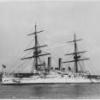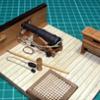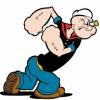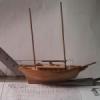-
Posts
6,366 -
Joined
-
Last visited
Reputation Activity
-
 wefalck got a reaction from coxswain in Functioning Mini-Cannons
wefalck got a reaction from coxswain in Functioning Mini-Cannons
Also did the match-scraping thing
The fuse would just stick out of the back of the canon. The barrel was about 3 cm long. I even shot with it in my room - mom was not amused 😳
These crackers used to have all sorts of names back in the 1960s/70s that would be totally politically incorrect today.
I must add that my father was a biochemist and apparently did make his own fireworks before WWII. There were several textbooks on the subject in his library, which of course I discovered in due time ...
-
 wefalck reacted to archjofo in La Créole 1827 by archjofo - Scale 1/48 - French corvette
wefalck reacted to archjofo in La Créole 1827 by archjofo - Scale 1/48 - French corvette
Hello,
I would like to present you a new Video LINK today.
It shows the main stages of making the masts for the French corvette.
I hope that you like it.
-
 wefalck reacted to archjofo in La Créole 1827 by archjofo - Scale 1/48 - French corvette
wefalck reacted to archjofo in La Créole 1827 by archjofo - Scale 1/48 - French corvette
Hello,
thanks for your feedback and "Likes", I appreciate your support a lot.
Currently I am producing the Gaff and the Boom for the Corvette.
There were many interesting details to clarify. So z. B. is located on the Gaff peak a small metal block for the national flag.
What is still to be clarified is the design of the Gaff goosenecks the boom.
Source: Auszug aus der Monographie zur La Creole von J. Boudriot
Source: William Dwight Whitney The Century Dictionary: An Encyclopedic Lexicon of the English Language (New York, NY: The Century Co., 1911)
Source: Text-Book of Seamanship, Commodore S. B. Luce, 1891
Source: Musée de la Marine (Bildausschnitt)
For the current building conditions of these components here a series of pictures:
Quelle: Musée de la Marine (Bildausschnitt)
&page=42#.url
&page=42#.url
-
 wefalck reacted to archjofo in La Créole 1827 by archjofo - Scale 1/48 - French corvette
wefalck reacted to archjofo in La Créole 1827 by archjofo - Scale 1/48 - French corvette
Hello Mark,
thanks for the tip.
I practice a lot, here are my modest results.
-
 wefalck got a reaction from CaptainSteve in Functioning Mini-Cannons
wefalck got a reaction from CaptainSteve in Functioning Mini-Cannons
Also did the match-scraping thing
The fuse would just stick out of the back of the canon. The barrel was about 3 cm long. I even shot with it in my room - mom was not amused 😳
These crackers used to have all sorts of names back in the 1960s/70s that would be totally politically incorrect today.
I must add that my father was a biochemist and apparently did make his own fireworks before WWII. There were several textbooks on the subject in his library, which of course I discovered in due time ...
-
 wefalck got a reaction from trippwj in question about sail position
wefalck got a reaction from trippwj in question about sail position
Good points. A good book on the rigging of ships of the period and region of interest should be in everyone's bookcase. Also a copy of Harland's 'Seamanship' would be a must for every half-way serious shipmodeller. Personally, I find it rather difficult to model something that I don't understand.
As for topping-lifts: the name itself may lead to the misconception and, hence, misrepresentation. The name seems to convey the idea that they serve to raise and lower the yards, while in reality the serve to stabilise them against swinging in the vertical plane. Although, for instance the German, French, Spanish and Italian do not convey the idea of 'lifting', modellers in these countries seem to fall into the same trap.
Having said that, I was aesthetically and otherwise rather surprised last weekend to see several of these modern square-rigged ships that have been fashioned from old trawler-hulls and the likes and that go by the denomination of 'windjammer' to not lower their yards down to the mast-caps, when sails are furled:
Images by S. Borgschulze on https://forum.arbeitskreis-historischer-schiffbau.de/
-
 wefalck got a reaction from Canute in Black wire for eye bolts/rings
wefalck got a reaction from Canute in Black wire for eye bolts/rings
It's the common or 'trivial' name for potassium polysulfide, i.e. K2Sx with x = 2 to 6.
-
 wefalck got a reaction from BANYAN in question about sail position
wefalck got a reaction from BANYAN in question about sail position
Good points. A good book on the rigging of ships of the period and region of interest should be in everyone's bookcase. Also a copy of Harland's 'Seamanship' would be a must for every half-way serious shipmodeller. Personally, I find it rather difficult to model something that I don't understand.
As for topping-lifts: the name itself may lead to the misconception and, hence, misrepresentation. The name seems to convey the idea that they serve to raise and lower the yards, while in reality the serve to stabilise them against swinging in the vertical plane. Although, for instance the German, French, Spanish and Italian do not convey the idea of 'lifting', modellers in these countries seem to fall into the same trap.
Having said that, I was aesthetically and otherwise rather surprised last weekend to see several of these modern square-rigged ships that have been fashioned from old trawler-hulls and the likes and that go by the denomination of 'windjammer' to not lower their yards down to the mast-caps, when sails are furled:
Images by S. Borgschulze on https://forum.arbeitskreis-historischer-schiffbau.de/
-
 wefalck got a reaction from coxswain in Functioning Mini-Cannons
wefalck got a reaction from coxswain in Functioning Mini-Cannons
Had a small brass cannon, about 6 mm bore. It was meant to fire dry peas or something like this with a spring mechanism. Found this not interesting enough and removed the spring. Charged it with some powder recovered from 'china-crackers', a wad and some small lead balls, and then screwed it down onto a table on our balcony. Luckily, I had the good sense to not stand behind it - the shot was a real 'success': the cannon ripped loose and made a big dent into the door about a 1 m behind it and the lead balls went right through the 4 mm-Plexiglas cover of the balcony, leaving a hole of about 15 mm diameter over a distance of 1.5 m ... luckily there was a large backyard behind. Must have been about 13 or so at the time 😯
And just remembered that I also had a little field gun, a plastic barrel with an aluminium tube as a liner. It was meant to be loaded with a 'lady-cracker', these were crackers of about 3 mm diameter that were sold in strings of a 100 or so to be fired together. I gather these things are neither sold to kids anymore, nor are they politically correct ...
-
 wefalck got a reaction from mtaylor in Black wire for eye bolts/rings
wefalck got a reaction from mtaylor in Black wire for eye bolts/rings
It's the common or 'trivial' name for potassium polysulfide, i.e. K2Sx with x = 2 to 6.
-
 wefalck reacted to jud in Functioning Mini-Cannons
wefalck reacted to jud in Functioning Mini-Cannons
Should not be much of a problem with ring bolts. As a kid, I made at least 6 out of various stock and used black powder in them without excessive recoil except for 2 instances, one was a little over a 30 cal and loaded it with ample powder packed well, used wading around a 30 cal bullet and rammed it, it was a boat tail or I couldn't have started it, I stapled it to a 2 X 4 and buried the 2 X 4 into a hole in the dirt and packed the ground around it, the gun was up about a 1/4 inch, block stayed where I put it but was loose after the stapling failed and the barrel moved about half it's length rearward. The other was a 8" brass napoleon that I bought, shot ball bearings and BB's in it. Wondered what it would do if I filled the bore clear up with black powder, so I did, leaving room for wading. that time it flipped over on it's back, no harm done to the gun. Normal loading of any of my guns never produced any destructive recoil, Force, Mass and Distance tamed it well. This one only shot full rolls of caps and made ample noise and some smoke. Was 13 when I put i together. Pulled the combine in wheat harvest the same year, that is Dad on the machine, plenty of work for a kid on a ranch in the 50s.
-
 wefalck reacted to JerseyCity Frankie in question about sail position
wefalck reacted to JerseyCity Frankie in question about sail position
The lower yards are called the Course Yards and they are more or less fixed in position and always remain at the same height above the deck regardless of sails on them being set or furled. The yards ABOVE the Course Yards are nearly always “Hoisting Yards” meaning they are hoisted up (using hailyards) when sail is set on them and then lowered down again when sails are furled. (Split topsails and split tagalents partially break this rule). The upper and lower positions the hoisting Yards can occupie are more or less determined by the masts they are attached to via their Parrels: the yards are hauled up as high as possible and lowered down as far as possible.
A shocking number of ship model builders don’t understand this and one often sees models with furled sails with all the yards hoisted high into their upper positions, a condition they wouldn’t ever realy be in on actual ships. Some model builders build their ships “bare polled” but position the yards high. There is ample room to debate this practice.
Another trap to fall into is misunderstanding the Lifts on hoisting Yards. Many smaller spar upper yards have lifts that don’t run, they are fixed lengths of line that can not be adjusted from the deck, they are only tight when the yards are in their lower positions and when the yards are hoisted up, the lifts droop dramatically. (Topsail Yards however have lifts that do run) Many model builders don’t understand these lifts and depict them as being tight with the yard hoisted.
-
 wefalck got a reaction from druxey in Albertic by michael mott - FINISHED - Scale 1:100 - RESTORATION - Bassett-Lowke Model
wefalck got a reaction from druxey in Albertic by michael mott - FINISHED - Scale 1:100 - RESTORATION - Bassett-Lowke Model
In the crate, she looked a bit like in the Canal of Corinth ...
Job very(!) well done ... I can imagine this feeling of emptiness, both physically and emotionally, but I understand that you have a project to fill that space
-
 wefalck got a reaction from popeye the sailor in Albertic by michael mott - FINISHED - Scale 1:100 - RESTORATION - Bassett-Lowke Model
wefalck got a reaction from popeye the sailor in Albertic by michael mott - FINISHED - Scale 1:100 - RESTORATION - Bassett-Lowke Model
In the crate, she looked a bit like in the Canal of Corinth ...
Job very(!) well done ... I can imagine this feeling of emptiness, both physically and emotionally, but I understand that you have a project to fill that space
-
 wefalck got a reaction from jud in Albertic by michael mott - FINISHED - Scale 1:100 - RESTORATION - Bassett-Lowke Model
wefalck got a reaction from jud in Albertic by michael mott - FINISHED - Scale 1:100 - RESTORATION - Bassett-Lowke Model
In the crate, she looked a bit like in the Canal of Corinth ...
Job very(!) well done ... I can imagine this feeling of emptiness, both physically and emotionally, but I understand that you have a project to fill that space
-
 wefalck got a reaction from cog in Albertic by michael mott - FINISHED - Scale 1:100 - RESTORATION - Bassett-Lowke Model
wefalck got a reaction from cog in Albertic by michael mott - FINISHED - Scale 1:100 - RESTORATION - Bassett-Lowke Model
In the crate, she looked a bit like in the Canal of Corinth ...
Job very(!) well done ... I can imagine this feeling of emptiness, both physically and emotionally, but I understand that you have a project to fill that space
-
 wefalck reacted to michael mott in Albertic by michael mott - FINISHED - Scale 1:100 - RESTORATION - Bassett-Lowke Model
wefalck reacted to michael mott in Albertic by michael mott - FINISHED - Scale 1:100 - RESTORATION - Bassett-Lowke Model
The journey for me is now over on this project, here is my last few pictures.
In the crate now and cleated down ready for the final close.
All ready to be picked up by the client.
The shop seemed a bit lost for a few hours.
The end
Michael
-
 wefalck reacted to bear in Steel files vs. diamond files
wefalck reacted to bear in Steel files vs. diamond files
Ahoy Mates
As an old tool and diemaker of over 45 years and model maker for over 60, I have used both and for the diamond files I love them on wood and steel for fast cutting and also use steel files. They both have their places.
I like the open cutting of the diamond's,they are like sandpaper,but for shapes and controled filing the steel ones are the best. Just make sure they are not stacked on each other or just tossed into a drawer.
Check out a jewler's supplier for files,they will have quality ones which cost more but will last you forever. The ones you get at a discount place mostly are not worth the price.
-
 wefalck got a reaction from mtaylor in Steel files vs. diamond files
wefalck got a reaction from mtaylor in Steel files vs. diamond files
Yes, chalk is an old mechanic's trick to prevent clogging by softer metals, such as brass and aluminium.
-
 wefalck got a reaction from mtaylor in Steel files vs. diamond files
wefalck got a reaction from mtaylor in Steel files vs. diamond files
I would not use diamond-files on (soft) metal. In comparison to a good steel-file they leave fines scratches on the surface. Also, cheaper ones tend to loose their diamond studding. Files have oblique cutting ridges with a defined geometry that smooth the metal, while diamonds have an undefined geometry and may stick out more or less, hence the risk of scratching. There are diamond- or boron-nitrate-files for honing, but this is another story.
-
 wefalck got a reaction from davyboy in Steel files vs. diamond files
wefalck got a reaction from davyboy in Steel files vs. diamond files
Yes, chalk is an old mechanic's trick to prevent clogging by softer metals, such as brass and aluminium.
-
 wefalck got a reaction from jud in Steel files vs. diamond files
wefalck got a reaction from jud in Steel files vs. diamond files
Yes, chalk is an old mechanic's trick to prevent clogging by softer metals, such as brass and aluminium.
-
 wefalck got a reaction from greenstone in Ship model terms in German. Where to find?
wefalck got a reaction from greenstone in Ship model terms in German. Where to find?
There are several native German speakers on this forum, including myself ...
-
 wefalck got a reaction from Canute in Steel files vs. diamond files
wefalck got a reaction from Canute in Steel files vs. diamond files
Yes, chalk is an old mechanic's trick to prevent clogging by softer metals, such as brass and aluminium.
-
 wefalck got a reaction from Canute in Steel files vs. diamond files
wefalck got a reaction from Canute in Steel files vs. diamond files
I would not use diamond-files on (soft) metal. In comparison to a good steel-file they leave fines scratches on the surface. Also, cheaper ones tend to loose their diamond studding. Files have oblique cutting ridges with a defined geometry that smooth the metal, while diamonds have an undefined geometry and may stick out more or less, hence the risk of scratching. There are diamond- or boron-nitrate-files for honing, but this is another story.













